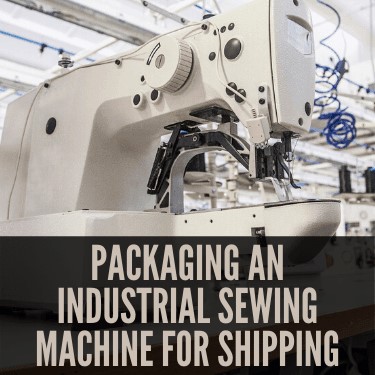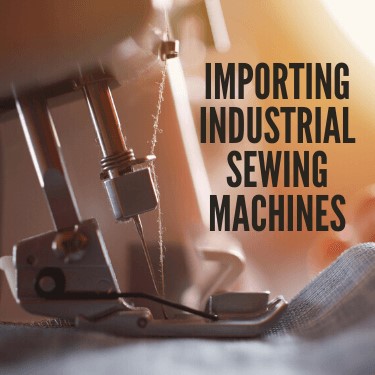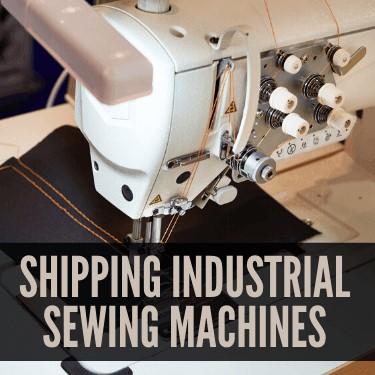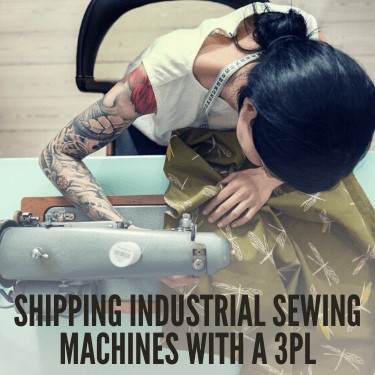Whether to create new products or repair existing ones, industrial sewing machines have a large place in some of America’s major industries. From clothing to leather goods to furniture, good stitching — and competent stitching machines — are needed to make these items. Knowing that is one thing, but the question of how to ship an industrial sewing machine is something totally different and can be a cause for concern if you’re unsure how to tackle it.
Thankfully, knowing how to ship an industrial sewing machine — or many of them — doesn’t have to be a thorn in your side. Many of these machines are produced in China, so knowing how to get them through customs and then onto a truck in the U.S. will be your biggest concern. Keep reading to learn comprehensively how to accomplish this.
Sewing machines can perform a wide array of different sewing techniques and are handy pieces of equipment to have in the manufacturing world.
A regular home sewing machine is meant to be more of a Swiss army knife and is used as an all-purpose device for personal or lighter sewing. Conversely, an industrial sewing machine comes in a variety of forms with each different one performing a certain kind of sewing very well.
An industrial sewing machine is typically built to be sturdy and durable for the many hours it is planned to be used on a daily basis. In turn, the price of an industrial sewing machine can easily reach into thousands of dollars since they are manufactured to hold up under strenuous amounts of work.
The motors powering industrial sewing machines will help produce more even stitching for heavy duty work and also be able to withstand the sudden starts and stops that are hallmarks of retail production. Industrial versions of these machines also allow a business to get work done much faster compared to a counterpart constructed for home or personal use.
The industry features three main types of industrial sewing machines:
But there are others that exist for very specific functions. For instance, machines exist that are specially built to sew leather, jeans, garments and upholstery. Or machines that are expertly used for a certain stitch length or even stitches per minute.
Popular brands include Singer, Brother, Juki, Consew, TechSew, Reliable, Highlead, New Tech and Janome, although this is far from an all-inclusive list.
One small note to remember as both a customer and seller of industrial strength sewing machines: they should be oiled once a year using a concoction made especially for them. Because there are many moving parts, this is essential to keep your machines in tip-top shape.
Need lab equipment shipping services? R+L Global Logistics can help move this kind of machinery, too.

While it is true that industrial sewing machines are built to last, the last thing you want to send to a customer who orders one from you is a dinged up, not fully functioning piece of machinery. Taking the necessary precautions to ensure this doesn’t happen can save you a lot of headaches on the back end.
Starting off, it is a good idea to wrap each machine inside bubble wrap or encase it in styrofoam. This will protect it against any external jostling or knocks it might come into contact with. Then the sewing machine will be placed in a box. Once it is in the box, it’s a great idea to fill the box with shipping paper or peanuts to restrict the sewing machine’s movement if the styrofoam or bubble wrap doesn’t already do that completely.
Since an industrial sewing machine can weigh upwards of 100 lbs., the box it is shipped in should be very sturdy and be able to comfortably bear the machine’s weight. Once that happens, the boxes can be placed on pallets and shrink wrapped to hold them in place so they don’t fall off during what could be a bumpy ocean journey.
Need to know how to transport leather and leather products? There's more to it than you might think.
With their high values and weights, it might cost you a bit more to ship industrial sewing machines than the average good. The reasoning is because these machines are worth thousands of dollars, it will cost more money to properly insure them against theft, loss or damage. Also since they are heavy items, you would theoretically be able to fit less individual machines into the back of a tractor trailer.
Since they are higher-value goods with the possibility of a bigger profit margin, this might not matter. But if you buy 1,000 industrial sewing machines for sale, that could be up to 100,000 pounds of merchandise. That means you’d need two full 18-wheelers instead of one.
Also, a freight shipping country is required under U.S. law to offer a limited amount of insurance to protect your cargo under certain circumstances. But the coverage offered as part of the base freight quote may not cover the entire value of your shipment, so it’s up to you to ask your transportation agent to help you procure additional cargo insurance or shop for it yourself through a third party. Ultimately, financially securing your load is going to be your responsibility, so taking these steps can be prudent in the long run.

Many industrial sewing machines are produced in China, meaning you’ll have to worry about importing them before they’re able to be shipped freely in the United States. This means the initial transport will take place aboard an ocean freighter and your order will have to pass through a U.S. port of entry and customs before you can take delivery of the machines and ship them to a warehouse for storage or to customers who’ve already ordered them.
The importation process is straightforward in theory but needs to be completed in an exacting manner that many first-timers will not be accustomed to. There are forms to be filled out, which must be complete and furnished with wholly accurate information. The penalty for not doing so can lead to the delay in your imported goods being able to clear customs or, worse, the shipment being rejected outright.
Also, if you are importing from overseas, you’ll have to ship your industrial sewing machines in a container hauled by a ship across the ocean. When taking into account when you need your valuable freight, know that ocean liners travel most efficiently when the journey takes 6 to 8 weeks. There is a possibility of getting your freight a little faster but the long, slow trip across the Pacific Ocean will take time and your ordering frequency should reflect that.
Before you can import items into the country, you will need to buy a customs bond. What this bond does is ensures that the U.S. government is able to collect the taxes and duties on your imports in the event that you’re unable to pay them at a later date.
You don’t have to do this all by yourself. Talked about in greater detail a bit later in this article, a third-party logistics (3PL) company can assist you in many of these aspects, or even take over certain parts of the process on your behalf.

Striking the balance between speed, cost and service level can be tricky when shipping your industrial sewing machines and there are also a lot of different modes of transport you can elect to use. So it’s good to look at the pros and cons of each different method and see which one (or which combination) will best fit your business needs.
Using this for shipping is a good bet because it is readily available, affordable and can offer true door-to-door service for U.S. domestic shipping. Its biggest limitations are that it can’t drive on water and it’s not as fast as a plane. With a truck, though, you get personalized service and can secure a truck just for your load. That wouldn’t necessarily be the case for the other three.
Using a box car on a rail can be the best option the further the distance is. If your freight is going from Miami to Seattle, for instance, a rail might be the best main option. On the flip side, since train tracks don’t usually roll right next to factories and warehouses, you’ll still need a truck before and after the train journey. So it can’t be used as the sole method of transportation. The cost of shipping via train will be similar to using a truck, cheaper than a plane but more expensive than a ship.
This works best for items coming overseas but can be used domestically as well. This is the cheapest level of shipping but also the slowest by far. When thinking about ocean shipping, you need to consider that your goods will arrive in weeks, not days. Also like train and plane shipping, you will still need a truck for some part of the journey.
This one will be short and sweet. If you need your sewing machines shipped as quickly as possible, ship them on an airplane. But if you’re worried about expense, then this is not for you. Air freight shipping will be cost prohibitive for many businesses, especially those working on thinner profit margins.
Keep in mind that the most likely outcome will be intermodal transportation for your products. Intermodal is when you use two or more methods of freight movement to complete a single journey.
Likely examples for shipping industrial sewing machines could include:
You might notice that none of the above examples of intermodal transport include using an airplane. That’s not because it’s impossible — it is — but using an airplane is always going to be the most expensive option by far, so it’s not generally used in this regard. There will also be very few instances where you need the machines in just hours or a day, so the cheaper cost of rail or truck will win out as a domestic option.

A third party logistics (3PL) company can really give your business a boost when it comes to importing and shipping industrial sewing machines and shipping machinery. A fully capable 3PL provider has access to many of the aspects that you need when your goal is to get your industrial sewing machines into the hands of the companies who need them.
This is the most obvious service a 3PL will offer your business. But it is even more comprehensive than just placing your freight into the back of a truck. An excellent 3PL can help your company plan everything out from the starting to ending point. This means helping you book ocean freight from overseas if needed or — if you’ve already gotten your industrial sewing machines to the U.S. on your own — simply getting them where you need them next.
But this also includes having an 18-wheeler ready to roll when you need it most and having your freight arrive in the agreed-upon timeframe. A reputable 3PL who treats you as a business partner and not just a mere customer will also make sure that your freight gets there in the new condition it was loaded onto the truck in.
You should never be concerned again about a part of the U.S. being unreachable. Except for Hawaii (for obvious reasons), a 3PL with far-reaching capabilities will be able to ship your load via truck throughout the other 49 states on the North American continent.
Most 3PL businesses have either integrated or have a separate branch of their operations that focus on helping their customers clear customs. A 3PL can help in many ways toward this particular goal.
First, the 3PL can help you fill out any forms associated with the importation of any freight like industrial sewing machines. The 3PL can also either sell you or procure for you a customs bond, which you will need in order to import any goods of value into the U.S.
Then, as an added value to you, the 3PL can also accept the goods on your behalf and begin the process of shipping them where you want them to go almost immediately. Overall, this can be a benefit to your importation of industrial sewing machines and take one part of the process off your plate that can be time-consuming and complex if you’re not already an expert.
If you have the industrial sewing machines in stock but haven’t sold them to a customer yet, then you’ll need a place to store them. A 3PL that has financial strength and a wide view will have multiple warehouse locations set up all over the country — and even all over the world. For a reasonable fee, the company will allow you to store pallets filled with industrial sewing machines if you so choose.
With many different warehouse locations, the sewing machines can be stored strategically so there is potentially less turnaround time once you decide what you’d like done with them. For instance, if you forecasted that most of your goods would end up in southern California, it would make sense to store them in a warehouse located in Los Angeles, San Diego or somewhere else in the area.
Furthering the commitment to helping you achieve your goals, a 3PL can also offer to do order fulfillment on your behalf. This occurs when your items are stored in the warehouse and an order comes in to you. You can then direct the 3PL where to ship this item to. Or if you need to ship a bunch of industrial sewing machines at once, the company warehousing your product can load it back onto a semi and ship it exactly where you require.
Now that you know how to ship an industrial sewing machine, reach out to R+L Global Logistics to handle all your transportation needs in relation to freight shipping. We will handle your sewing machines with the speed and care they demand, while doing so at a competitive price that doesn’t stretch your budget.
At R+L Global Logistics, we believe in being on time and the numbers bear that out. We are proud of our 99.5 percent on-time delivery rate, which signals our commitment to having your freight to the designated place at the time you need it there.
Should you find yourself in a spot where you require a faster rate of transport, look no further than R+L Global Logistics’ expedited shipping. This is still an 18-wheeler hauling your products, but — depending on the distance — the freight can get there in up to 2 days faster.
Besides standard and expedited shipping, R+L Global Logistics has additional services to offer. For instance, we can offer warehousing space for your sewing machines so they are in a strategic location at one of our many warehouses. Furthermore, we can offer supply chain management which includes us engaging in order fulfillment on your behalf.
So now that you’re acquainted with how to ship an industrial sewing machine, get a free freight shipping quote today from R+L Global Logistics by calling us at 866.353.7178.
R+L Global Logistics
315 NE 14th St., Ocala, FL 34470